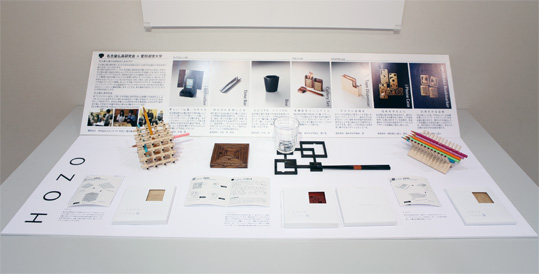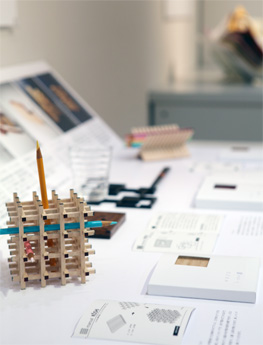

— A souvenir created using the techniques for making Nagoya butsudan and butsugu (Buddhist household altars and ritual articles, respectively), expressing the warmth of wood.
Even though Nagoya leads the nation both in the number of Nagoya butsudan craftspeople and in butsugu production, most Nagoyans are unaware of this distinction. Today, because younger households are unlikely to have a butsudan, many younger people have no contact with butsudan as a part of everyday life, and the high price means that they cannot easily purchase one. Our aim was to produce a souvenir for everyday use, utilizing the kumiki-hozogumi technique*, the principal characteristic of Nagoya-butsudan craftwork, with the support of the Society for the Study of Nagoya-Butsugu. Our ready-to-assemble souvenir is compact and portable, so just by affixing a stamp, one can mail it with some memories of a trip to Nagoya. We thought that in creating the structure, not only will the recipient enjoy practicing the kumiki-hozogumi technique, but that this souvenir would give people around Japan the opportunity to experience the amazing technique craftspeople utilize in making both altars and ritual articles, and become aware of traditional Nagoya-butsudan craftwork.
Aichi Shukutoku University: Yuji Shimizu
At Yuji Shimizu’s research laboratory in Aichi Shukutoku University, students came up with a Nagoya souvenir in collaboration with craftspeople in Nagoya who create butsudan and butsugu (Buddhist household altars and ritual articles, respectively). First, we’d like to thank the members of the Society for the Study of Nagoya-Butsugu who provided both experience and support. The students, motivated by the enthusiasm of the craftspeople, came up with a variety of ideas, and the craftspeople, responding to their zeal, helped give shape to those ideas. I’m sure this souvenir will give people throughout Japan the opportunity to learn about the highly sophisticated skills practiced by the craftspeople who create Nagoya-butsudan and butsugu. It was also very meaningful to have the souvenirs exhibited in both the participant cities: Nagoya and Kobe, and to give the students an opportunity to present in both cities, helping them directly experience the environment and atmosphere of each.
Our students were very much inspired by both high praise and direct criticism from the Kobe commentators. Responding to this opportunity, we’d like to continue to participate in activities like this that help connect our cities, and improve design practice for all.